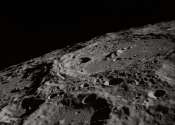Spacecraft to swing by Earth, moon on path to Jupiter
A spacecraft launched last year will slingshot back around Earth and the moon next month in a high-stakes, world-first maneuver as it pinballs its way through the solar system to Jupiter.

A spacecraft launched last year will slingshot back around Earth and the moon next month in a high-stakes, world-first maneuver as it pinballs its way through the solar system to Jupiter.
Space Exploration
7 hours ago
0
34

In July 2024, NASA announced it canceled its plans to send the Volatiles Investigating Polar Exploration Rover (VIPER) to the moon's southern polar region. The rover was meant to search for water and other resources called ...
Space Exploration
Jul 25, 2024
0
16

A Chinese lunar probe found traces of water in samples of the moon's soil, scientists have said, as the country pushes its ambitious space program into high gear.
Planetary Sciences
Jul 23, 2024
0
164

It's still covered up in what looks like the world's largest PEZ dispenser, but the core stage booster for NASA's Space Launch System rocket for the Artemis II moon mission arrived by barge to Florida on Tuesday.
Space Exploration
Jul 23, 2024
0
61

NASA's LEGS can do more than help Earthlings move about the planet. Three Lunar Exploration Ground Sites, or LEGS, will enhance the Near Space Network's communications services and support of NASA's Artemis campaign.
Space Exploration
Jul 23, 2024
0
17

Water purification is a big business on Earth. Companies offer everything from desalination to providing just the right pH level for drinking water. But on the moon, there won't be a similar technical infrastructure to support ...
Space Exploration
Jul 23, 2024
0
4

The cosmos is providing a full moon for the 55th anniversary of the first lunar landing this weekend, and plenty of other events honor Neil Armstrong and Buzz Aldrin's giant leap.
Space Exploration
Jul 19, 2024
0
29

Europa, a moon of Jupiter, and Enceladus, a moon of Saturn, have evidence of oceans beneath their ice crusts. A NASA experiment suggests that if these oceans support life, signatures of that life in the form of organic molecules ...
Astrobiology
Jul 18, 2024
0
22

NASA announced Wednesday that cost overruns and delays have forced it to cancel a planned moon rover it already spent $450 million to develop, marking a significant setback for the agency's lunar exploration program.
Space Exploration
Jul 18, 2024
4
20

The next full moon will be Sunday morning, July 21, 2024, appearing opposite the sun (in Earth-based longitude) at 6:17 AM EDT. For the International Date Line West and the American Samoa and Midway time zones this will be ...
Space Exploration
Jul 18, 2024
0
27
The Moon is Earth's only natural satellite and the fifth largest satellite in the Solar System. The average centre-to-centre distance from the Earth to the Moon is 384,403 km, about thirty times the diameter of the Earth. The common centre of mass of the system (the barycentre) is located about 1,700 km—a quarter the Earth's radius—beneath the surface of the Earth. The Moon makes a complete orbit around the Earth every 27.3 days (the orbital period), and the periodic variations in the geometry of the Earth–Moon–Sun system are responsible for the phases of the moon, which repeat every 29.5 days (the synodic period).
The Moon's diameter is 3,474 km, a little more than a quarter of that of the Earth. Thus, the Moon's surface area is less than a tenth that of the Earth (about a quarter the Earth's land area, approximately as large as Russia, Canada, and the United States combined), and its volume is about 2 percent that of Earth. The pull of gravity at its surface is about 17 percent of that at the Earth's surface.
The Moon is the only celestial body to which humans have traveled and upon which humans have performed a manned landing. While the Soviet Union's Luna program was the first to reach the Moon with unmanned spacecraft, the NASA Apollo program by the United States achieved the only manned missions to date, beginning with the first manned lunar mission by Apollo 8 in 1968, and six manned lunar landings between 1969 and 1972- the first being Apollo 11 in 1969. Human exploration of the Moon temporarily ceased with the conclusion of the Apollo program, although a few robotic landers and orbiters have been sent to the Moon since that time. The U.S. has committed to return to the moon by 2018.
This text uses material from Wikipedia, licensed under CC BY-SA